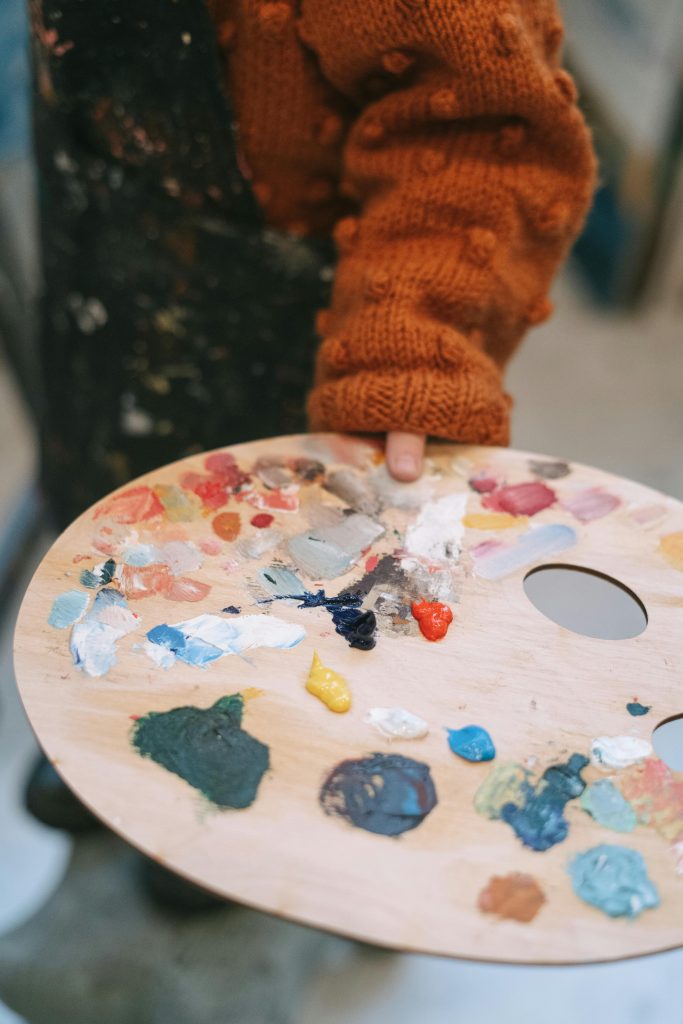How to Keep Portfolio Text Clear and Effective

When most artists sit down to update their portfolio, the images take center stage. The paintings, sculptures, or digital works naturally shine brightest, so the text is often treated like an afterthought. But here’s the thing: the words you choose to sit alongside your visuals can either pull people in or quietly push them away. Think about the last time you visited an artist’s page online. Did the words feel like they matched the energy of the work? Or did you skim because they sounded stiff or overly formal? Those little moments matter more than we realize.
A clear portfolio text works like a tour guide. It doesn’t need to explain everything about your art, but it should give enough context that the viewer feels grounded and curious to see more. Without it, people can get lost, and instead of leaning in, they step back. That’s a missed chance for connection. And in art careers, connection is what translates into opportunities, whether that’s an exhibition invite, a collector’s interest, or even a collaboration with someone who simply resonated with your story.
Think of portfolio text as the voice-over in a documentary. The images do the heavy lifting visually, but the voice-over brings clarity, meaning, and rhythm. You can create that same experience for your viewers, letting your art speak while your words act as a companion, not a competitor.
Many artists worry that they’re “bad with words,” but writing portfolio text isn’t about poetry or essays. It’s about making the viewer feel at ease and giving them an anchor. You’re not trying to impress an English professor, you’re trying to let your audience understand why the work matters.
This doesn’t mean you have to spell out everything. Vagueness is frustrating, but overexplaining drains the magic too. The sweet spot is somewhere in between, where the words support the work rather than overshadowing it. When you hit that balance, you create something that feels both professional and personal.
So if your current portfolio text feels stiff, rushed, or generic, don’t beat yourself up. Almost every artist starts there. The good news is, with a few adjustments, your words can carry the same energy as your art and make your whole portfolio feel sharper and more alive.
Writing Like You’re Talking to a Friend
The best portfolio text doesn’t sound like a textbook, it sounds like a human being speaking directly to another human being. If you can explain your art over coffee with a friend, then you already know how to write a solid portfolio. The challenge is translating that relaxed, natural tone into written words without making it feel sloppy or unprofessional.
One trick is to actually record yourself describing your work. Don’t script it, just talk out loud as if you were telling a curious friend why you made the piece and what it means to you. Later, write down the parts that feel clear and genuine. This method helps strip away the stiffness that creeps in when we try to sound “serious” or “academic.”
When jurors or curators read portfolio text, they’re not looking for polished literature. They’re looking for clarity, confidence, and an authentic sense of voice. They want to know what drives you, what the work is rooted in, and how it connects to bigger ideas. You don’t need long words or heavy jargon to do that.
Imagine walking into a gallery and seeing a piece that catches your eye. Now imagine the wall text next to it is full of jargon, theories, and obscure references. Most people stop reading halfway through. But if the text is clear, conversational, and welcoming, you keep going, and that small act deepens your engagement with the work. That’s what you want in your portfolio.
Being conversational also makes your text easier to update. If you’re not bending over backward to sound academic, you can adjust it quickly as your work evolves. This keeps your portfolio alive and in sync with your creative growth, rather than stuck in the tone you used three years ago.
At its core, good portfolio text is just storytelling. And storytelling is something every artist already does through their work. You’re just moving that skill into words, making sure the person on the other side feels the same sense of connection they’d feel if they were standing in front of your canvas with you by their side.
Keeping It Short Without Cutting the Heart Out
One of the easiest mistakes artists make with portfolio text is going on too long. There’s a fear that if you don’t explain every angle, people won’t get it. But in reality, clarity often comes from saying less, not more. A short, thoughtful statement has far more impact than a long, meandering explanation.
Think about how people consume portfolios today. Whether online or in print, attention spans are short. Curators and jurors may look at dozens of applications in one sitting. If your text runs three pages long, you’re not doing yourself any favors. What they need is something they can grasp in one or two quick reads that gives enough to spark interest without bogging them down.
Keeping it short doesn’t mean stripping out personality. It just means being selective. What’s the one or two threads you really want people to hold onto? If someone walked away remembering just one sentence, what would you want it to be? That’s your anchor, and everything else should support it.
You can think of it like a trailer for a film. A trailer doesn’t tell the whole story, but it gives enough glimpses to make you want to see the full movie. Your portfolio text works the same way. You’re offering a peek into your ideas and process without spelling out every detail.
A practical tip is to write everything out first without worrying about length, then come back and cut half of it. You’ll be surprised how much fluff sneaks in when you’re trying to sound thorough. Cutting forces you to sharpen your words, which makes them stronger.
The heart of your work should still come through. If you’ve got too many sentences that sound vague or repetitive, they’re weighing down your message. Once you trim those, you’ll find the text feels fresher, cleaner, and more reflective of the energy in your actual art.

Choosing Words That Match Your Visual Language
Just as every artist develops a visual language, your words can carry that same fingerprint. The trick is making sure the text mirrors the tone of your work. If your art is bold, playful, and colorful, then stiff academic writing creates a disconnect. If your art is subtle and meditative, then overly casual words might feel jarring.
Start by noticing the qualities in your work that people often comment on. Do they describe it as vibrant, haunting, calming, or experimental? Those adjectives can guide your writing tone. If your work feels dynamic, your text can lean toward energetic and crisp. If your work feels delicate, your text can slow down and create space.
Matching your writing style to your visual style doesn’t mean you have to box yourself in. It just ensures that the viewer’s experience feels seamless. The last thing you want is for someone to be drawn in by your art and then thrown off by text that feels like it belongs in a different world.
A good exercise is to write three different versions of the same description, each in a slightly different tone. One could be formal, one conversational, and one poetic. Then ask yourself which one feels most aligned with how your work actually lives in the world. This experiment helps you notice whether your natural writing instincts are in sync with your art.
It also helps to avoid clichés. Words like “exploring,” “challenging,” or “navigating” are so overused in artist statements that they’ve lost impact. Dig deeper into what you really mean. Instead of saying “my work explores memory,” try “my work pieces together fragments of childhood stories into physical form.” One is generic, the other is tangible.
When the words match your art, the whole portfolio feels like one continuous piece of communication. The text doesn’t feel separate or forced, it feels like another layer of your practice that reinforces the same story your visuals are already telling.
How Examples and Stories Make Text Stick
Facts can inform, but stories make people remember. If you want your portfolio text to feel alive, weaving in examples and little snapshots of your process can make a huge difference. It doesn’t need to be dramatic or personal, just something that gives the reader a glimpse into how you think and create.
For example, instead of writing “I use found objects in my work,” you could say, “I once picked up a rusted key from a street corner, and it became the starting point for a whole series.” The second version not only informs but creates an image in the reader’s mind. That mental picture makes your text much more memorable.
Stories also help bridge the gap between artist and viewer. For someone unfamiliar with your practice, a small anecdote can make the work relatable. Maybe you describe how a certain color palette came from watching sunsets in your hometown, or how the rhythm of your brushstrokes echoes the music you listen to in the studio. Those details connect your process to everyday experiences people can understand.
The key is balance. Too many stories can make your text feel cluttered, while none can leave it feeling dry. Aim for one or two vivid examples that highlight your larger themes. Think of them as seasoning in a recipe, enough to add flavor without overwhelming the dish.
These little glimpses also create a sense of authenticity. Readers can tell when an artist is trying too hard to sound impressive, and they can tell when someone is simply sharing their truth. The latter always lands better, even in professional settings.
By grounding your text in real stories, you also make it easier for yourself. You’re not scrambling for the “right” words, you’re just sharing a slice of your process. And when you approach it that way, writing becomes less of a chore and more of an extension of the creative act itself.
Editing Like a Collaborator, Not a Critic
The editing stage is where your portfolio text really comes to life. But instead of treating editing like punishment, treat it like collaboration. You and your text are working together to say what needs to be said, nothing more and nothing less.
Start by reading your text out loud. This simple step reveals awkward phrasing, overly long sentences, or spots where the rhythm drags. If it sounds clunky when spoken, it’ll feel clunky when read. Editing is about smoothing those rough patches so the words flow as naturally as conversation.
Next, ask a trusted friend to read your text, not to critique it like a teacher, but to share how it lands. Did they understand what you meant? Did they get a sense of your voice? Did anything confuse them? Their feedback can help you spot blind spots that you missed.
Another helpful trick is to leave your text for a day or two, then revisit it with fresh eyes. Distance gives you perspective, and suddenly you’ll notice which sentences are doing heavy lifting and which ones are just filler.
Think of editing as sculpting. You start with a block of clay, and through patient shaping, you reveal the form. Every cut and adjustment sharpens the piece until it matches what you intended. Your portfolio text deserves that same slow, intentional care.
The goal isn’t perfection, it’s clarity. If someone can read your portfolio and walk away with a clear sense of your work, your motivations, and your style, then you’ve succeeded. That clarity builds trust, and trust is what turns casual viewers into serious supporters.
When you treat editing as a collaboration rather than a battle, the process becomes much lighter. Instead of dreading revisions, you start looking forward to the moment when your words finally align with your art.
Why Less Really Is More When Writing About Your Art
Think about the last time you read an artist statement that felt like it was trying too hard. Maybe it was packed with complicated words or lofty ideas that left you scratching your head. That happens more often than you’d expect, and the truth is, jurors, curators, or collectors don’t have the time or energy to decode confusing language. Clear, simple writing can actually feel more powerful because it respects the reader’s attention.
Imagine explaining your work to a friend over lunch. You wouldn’t use academic jargon or weave in half a dozen art theory references. You’d just say what inspired you, what materials you used, or why this subject matters to you. That’s the kind of straightforwardness that makes portfolio text approachable. It lets your personality shine instead of hiding behind a wall of big words.
Clarity also makes your art feel more accessible. Someone who might not have a deep background in art should still be able to connect with your words. When you strip things down to what really matters, you invite people into your world rather than pushing them out. That simple shift often makes your work stick in their memory.
A lot of artists worry that simple writing will make them seem less serious. In practice, it usually does the opposite. It shows confidence in your ideas and trust that your art can speak for itself. Instead of trying to impress, you’re aiming to connect, and that’s a quality every reader responds to.
So, whenever you feel the urge to overexplain or add unnecessary layers, pause. Ask yourself, “Would this make sense to someone outside the art world?” If the answer is no, consider trimming it back. The goal is never to water down your thoughts, but to make them clear enough that your audience doesn’t need a translator.
Less isn’t about cutting corners, it’s about amplifying the core of your message. When your words and your art align in their honesty, you create the kind of resonance that lasts.
The Power of Storytelling in Your Portfolio Text
Here’s something people often forget: portfolio text doesn’t have to be stiff or purely descriptive. A well-placed story can bring your work to life in a way that lists of materials or techniques never could. Think about the difference between reading “oil on canvas, 2023” and hearing about how a fleeting sunset inspired the colors in a piece. The second option paints a picture in the reader’s mind.
Stories don’t need to be long or overly detailed. A quick anecdote about how you found your subject, or the moment an idea sparked, can give your work a human touch. Readers might not remember every technical detail, but they’ll remember how they felt when they heard your story. That feeling often makes the difference in whether they form a lasting connection with your art.
For example, say you’re writing about a sculpture made of recycled materials. Instead of only saying “constructed from discarded wood,” you could share how you came across those scraps during a morning walk in your neighborhood. Suddenly the piece has roots in a real, lived moment. That glimpse into your process makes the work richer for your audience.
Of course, storytelling isn’t about spilling your entire life story. It’s about finding the details that bring your art closer to the reader. A single line that captures a sensory moment, like the smell of paint in your studio or the sound of rain hitting the roof while you worked, can go a long way.
Think of it like seasoning food. Too much can overwhelm, but just enough makes everything come alive. Your words should complement your art, not drown it out. The best portfolio texts balance description with emotion, and a little storytelling is often the bridge between the two.
So don’t be afraid to weave in small narratives. They’re the hooks that catch attention and make your work memorable in a crowded field of portfolios.

Writing for Different Audiences Without Losing Your Voice
Here’s a challenge many artists run into: tailoring their text for different readers while staying true to themselves. Your portfolio might be seen by curators, jurors, potential buyers, or even casual art lovers. Each group has its own perspective and level of familiarity with art. The key is to strike a balance where you’re speaking clearly to all of them without bending yourself out of shape.
Think of it like adjusting how you explain your work depending on who’s listening. If you’re chatting with a fellow artist, you might talk in more technical terms about materials or influences. If you’re speaking with someone new to art, you’d lean more into story and feeling. Both explanations are valid, they just highlight different parts of the same truth.
One way to make this easier is to write your text with a “universal reader” in mind. Imagine someone curious and intelligent, but not necessarily trained in art. If your words make sense to them, they’ll make sense to almost everyone. This doesn’t mean dumbing things down, it means communicating without unnecessary barriers.
Another useful trick is to write different versions of your text. Maybe you keep a longer, more detailed version for gallery submissions and a shorter, punchier one for your website. Having a few variations ready saves you from scrambling to rewrite under deadline pressure. It also helps you see your work from different angles, which can deepen your own understanding.
At the end of the day, your voice should remain consistent. Readers should be able to recognize your personality across all formats, whether it’s a one-line caption or a full artist statement. That consistency builds trust and shows you’re not just tailoring your words to please, but genuinely sharing who you are.
The real win is when your writing feels authentic to you, yet flexible enough to resonate with different audiences. That’s when your portfolio text becomes more than an explanation, it becomes a conversation.
Editing Tricks That Make Your Text Shine
Drafting your portfolio text is only half the work. Editing is where clarity and polish really happen. Many artists dread editing because it feels tedious, but it’s actually one of the most empowering steps. It’s where you take the raw material of your thoughts and shape it into something that truly represents you.
Start by reading your text out loud. If you trip over words or lose your train of thought while speaking, chances are your reader will too. Hearing your words helps you catch clunky phrasing and overly long sentences. It also makes it easier to check if the tone feels natural, like you’re talking to someone rather than delivering a lecture.
Another trick is to step away from your writing for a day or two. Coming back with fresh eyes often makes the weak spots obvious. You might notice where you rambled, repeated yourself, or left gaps that need filling. Editing with distance gives you perspective, and that’s something no spell-check tool can replace.
It’s also worth focusing on verbs. Strong, active verbs give your writing energy. Instead of saying “this piece was created to explore,” you could say “this piece explores.” That small shift makes your text feel more confident and alive.
And don’t underestimate the power of cutting. Most texts get stronger when unnecessary words are trimmed. If a sentence doesn’t add clarity, context, or connection, it’s probably safe to remove. Think of it like sculpting, chipping away what isn’t needed so the essence can shine.
Editing doesn’t have to be lonely, either. Sharing your draft with a trusted friend and asking for honest feedback can be eye-opening. Sometimes they’ll catch things you completely overlooked, or they’ll tell you what parts of your story hit hardest. That outside perspective can sharpen your work in ways you can’t achieve alone.
Common Pitfalls That Weaken Portfolio Writing
It’s easy to fall into traps when writing portfolio text, especially if you’re trying to impress. One of the most common missteps is overloading your writing with jargon. While terms like “interrogating form” or “deconstructing narrative” might sound academic, they often leave readers cold. Clear, grounded language tends to stick better.
Another pitfall is writing too vaguely. Saying your work “explores identity” without specifics doesn’t give the reader much to hold on to. Instead, mentioning how your art reflects personal experiences or responds to a certain environment gives it real weight. Specifics always beat generalities.
Some artists also run into the issue of making their text too long. While detail is valuable, it’s possible to drown your reader in information. Remember, most people looking at portfolios are juggling dozens of submissions. They appreciate brevity paired with clarity. Respecting their time works in your favor.
On the flip side, writing too little can be just as damaging. A one-sentence description might feel mysterious to you, but to a juror or curator it looks unfinished or careless. Your text doesn’t have to be an essay, but it should show thought and effort.
Another subtle pitfall is trying to imitate other artists’ statements. It’s tempting to copy a style you admire, but if it doesn’t fit your voice, it comes across as forced. Readers can sense when writing feels unnatural. Authenticity, even if imperfect, always resonates more.
Finally, don’t forget about structure. A wall of text with no breaks is exhausting to read. Using short paragraphs makes your writing digestible and keeps the reader engaged. Presentation counts, and the way your words look on the page can influence how they’re received.
Keeping Words and Art in Harmony
At the end of the day, portfolio text isn’t about impressing anyone with vocabulary or writing skills. It’s about making sure the words you put alongside your art help others connect with it. Think of your text as a bridge. On one side is your creative world, and on the other is the audience. A good bridge is strong, clear, and inviting.
Writing in this way doesn’t mean stripping your art of its depth. It means finding words that reflect that depth in a way people can actually engage with. Simple, honest sentences can hold just as much power as elaborate ones, sometimes more.
The most effective portfolio texts feel like conversations. They make the reader feel like you’ve let them into your process, even for a moment. That intimacy builds trust and helps your work stand out in a sea of submissions.
Remember too that writing about your art is a skill, just like drawing, painting, or sculpting. The more you practice, the easier it becomes. With each draft and edit, you’ll grow more comfortable expressing yourself in words.
So, whether you’re submitting to open calls, building a website, or just updating your portfolio for yourself, treat your text with care. It’s not an afterthought, it’s part of the package that represents you.
And if you ever get stuck, picture yourself sitting across from someone curious about your art. What would you say to them? Chances are, that’s exactly what your portfolio text needs to be.
